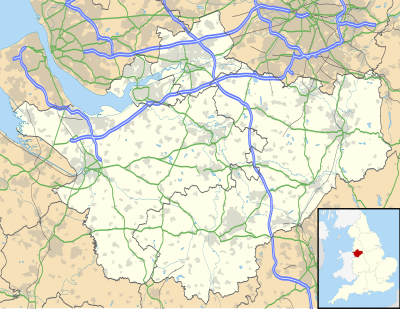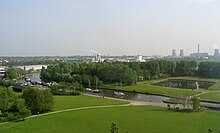|
The Cheshire Portal
WelcomeCheshire Plain from the Mid Cheshire Ridge
Cheshire is a ceremonial county in the North West of England. Chester is the county town, and formerly gave its name to the county. The largest town is Warrington, and other major towns include Congleton, Crewe, Ellesmere Port, Macclesfield, Nantwich, Northwich, Runcorn, Sandbach, Widnes, Wilmslow and Winsford. The county is administered as four unitary authorities. Cheshire occupies a boulder clay plain (pictured) which separates the hills of North Wales from the Peak District of Derbyshire. The county covers an area of 2,343 km2 (905 sq mi), with a high point of 559 m (1,834 ft) elevation. The estimated population is a little over one million, 19th highest in England, with a population density of around 450 people per km2. The county was created in around 920, but the area has a long history of human occupation dating back to before the last Ice Age. Deva was a major Roman fort, and Cheshire played an important part in the Civil War. Predominantly rural, the county is historically famous for the production of Cheshire cheese, salt and silk. During the 19th century, towns in the north of the county were pioneers of the chemical industry, while Crewe became a major railway junction and engineering facility. Selected articleThe Peak District is an upland area of England that forms the southern end of the Pennines. Lying mainly in northern Derbyshire, the region also covers the east of Cheshire, as well as several other counties. Most of the area falls within the Peak District National Park, the first National Park in England and Wales to be designated and, as of 2018, the fifth largest. The Cheshire region forms part of the South West Peak area of the Dark Peak, whose gritstone and shale supports heather moorland and blanket bog environments. Rough sheep pasture and grouse shooting are the main land uses. Features include the hills and edges of Shining Tor, Shutlingsloe, Tegg's Nose, The Cloud and Windgather Rocks, the Dane, Dean and Goyt rivers, and the woodland of Macclesfield Forest. The national park attracts millions of visitors every year, with tourism forming a major part of the economy. Recreational activities include walking, climbing, caving, fell running, orienteering, horse riding, cycling, hang gliding, paragliding and birdwatching on the fells; sailing, fishing and canoeing on reservoirs such as Lamaload; and visiting historic houses such as Lyme Park. Selected imageSalt-making by the open-pan method dates back to the Roman occupation, and was one of Cheshire's major industries. The Lion Salt Works was the last place in the county to use the method. It closed in 1986, when this picture was taken, and is now a museum. Credit: Chris Allen (8 June 1986) In this month1 February 1863: Artist and printmaker John Romney died in Chester. 1 February 1869: The first goods train crossed Runcorn Railway Bridge. 3 February 1646: Chester surrendered during the Civil War. 3 February 1857: First meeting of Cheshire Police committee. 3 February 1885: Foundation stone of Grosvenor Museum laid by the Duke of Westminster. 4 February 1253–4: Lordship of Chester gifted to Edward, heir of Henry III. 5 February 1977: Olympic gold medallist sailor Ben Ainslie born in Macclesfield. 6 February 1987: Lindow III discovered at Lindow Moss. 9 February 1539: First recorded race at Chester Racecourse. 13 February 1839: Riot at Chester Castle in support of poachers awaiting trial. 14 February 1926: Fire partially destroyed Oulton Hall. 15 February 1918: Physicist John Holt born in Runcorn. 19 February 1943: Nobel prize winning biochemist Tim Hunt born in Neston. 20 February 1643: Beeston Castle seized from the Royalists by Parliamentary forces commanded by Sir William Brereton (pictured). 20 February 1907: Radar pioneer Skip Wilkins born in Chorlton. 21 February 2008: Sunny Lowry, first woman to swim the Channel, died in Warrington. 26 February 1993: IRA explosive devices went off at Warrington gasworks. Selected listMany Cheshire museums focus on the area's industrial heritage, including Quarry Bank Mill and Clarence Mill (cotton), the Macclesfield Museums (silk), the Catalyst Science Discovery Centre (chemicals), and the Lion Salt Works and Weaver Hall Museum (salt). Poynton's Anson Engine Museum is on the site of a former colliery. Jodrell Bank Discovery Centre explores astronomy. There are also several transport museums, including the Crewe Heritage Centre (railways), the National Waterways Museum in Ellesmere Port, and the Anderton Boat Lift (canals). There are water-powered mills at Bunbury, Nether Alderley and Stretton. Chester and Warrington have combined museums and art galleries, Grosvenor and Warrington Museums, and Congleton and Nantwich have local museums. Norton Priory is the remains of an Augustinian abbey, and Englesea Brook Chapel documents the Primitive Methodist movement. Historic house museums are also represented in the county, including Little Moreton Hall and Lyme Park. Cheshire Military Museum in Chester Castle covers the county's regimental history, and RAF Burtonwood and Hack Green Secret Nuclear Bunker explore more recent military history. The Museum of Policing in Warrington documents Cheshire's police forces. Unusual specialist museums include Cuckooland Museum (pictured), which exhibits cuckoo clocks. GeographyTop: Map of modern Cheshire showing urban areas (grey) and the major road network. Chester (red) is the county town, and Warrington has the greatest population. Towns with more than 10,000 inhabitants in 2011 are highlighted; the size of dot gives a rough indication of the relative population. Wales and the adjacent English counties are shown in capitals. Bottom: Relief map showing the major hills. The Mid Cheshire Ridge is a discontinuous ridge of low hills running north–south from Beacon Hill (north of Helsby Hill) to Bickerton Hill. Most other high ground falls within the Peak District in the east of the county. Shining Tor (559 metres), on the boundary with Derbyshire, forms the county's high point. Administration The ceremonial county of Cheshire is administered by four unitary authorities (click on the map for details): 2 – Cheshire East 3 – Warrington 4 – Halton In the local government reorganisation of 1974, Cheshire gained an area formerly in Lancashire including Widnes and Warrington. The county lost Tintwistle to Derbyshire, part of the Wirral Peninsula to Merseyside, and a northern area including Stockport, Altrincham, Sale, Hyde, Dukinfield and Stalybridge to Greater Manchester. Selected biographyRowland Eyles Egerton-Warburton (14 September 1804 – 6 December 1891) was a Cheshire landowner, garden designer and poet. Born at Norley, he inherited the Arley and Warburton estates, and is best remembered for rebuilding Arley Hall and its chapel, in association with the young Nantwich architect George Latham. With his wife, he designed formal gardens for the hall, including one of Britain's earliest herbaceous borders. The hall and its gardens are now an important tourist attraction. A keen fox hunter, he served as president of the Tarporley Hunt Club. His poetry collection, Hunting Songs, ran to eight editions, and some of his rhymes remain on signposts in the Arley Hall grounds. A major local benefactor, he built or restored three churches, two schools, a church hall, post office, public road and multiple cottages, many of which were designed by Chester architect John Douglas. He is particularly known for his work in giving the village of Great Budworth, "one of Cheshire's most charming villages", its present picturesque appearance. Did you know...
Selected town or villageWidnes is an industrial town on the northern bank of the River Mersey, where the estuary narrows to form the Runcorn Gap. Historically in Lancashire, it became part of Cheshire in 1974, within the borough of Halton. It had a population of a little over 60,000 in 2011. Before the Industrial Revolution, Widnes consisted of a small number of separate settlements on predominantly marsh and moorland. In 1847, the first chemical factory was established, and the town rapidly became a major centre of the chemical industry using immigrant workers from Ireland, Poland, Lithuania and Wales. The town was described in 1888 as "the dirtiest, ugliest and most depressing town in England". Although there has been a degree of diversification of the town's industries, Widnes remains a major manufacturer of chemicals. Spike Island (pictured), where the disused Sankey Canal terminates, has been reclaimed as a recreational area. The nearby Catalyst Science Discovery Centre is the world's first museum dedicated to the chemical industry. In the news29 October, 1 November: Warrington council and the mayor of Crewe each announce plans to bid for city status in 2022. 13–14 October: Prince Edward visits Chester and opens a Fire Service training centre in Winsford. 8 October: Castle Street shopping area in Macclesfield reopens after refurbishment. 4 October: Restoration of the grade-I-listed Bridgegate, part of Chester city walls, is completed. 25 September: A bronze frieze by the sculptor Tom Murphy is unveiled in Warrington, as a memorial to the band Viola Beach. 9 September: The fifth stage of the Tour of Britain cycle race takes place in Cheshire, starting at Alderley Park and finishing in Warrington. 24 July: The grade-II-listed Crewe Market Hall (pictured) formally reopens after refurbishment. 15 July: Crewe, Runcorn and Warrington are awarded potential funding under the "Town Deal" government scheme. QuotationThe tortuous wall—girdle, long since snapped, of the little swollen city, half held in place by careful civic hands—wanders in narrow file between parapets smoothed by peaceful generations, pausing here and there for a dismantled gate or a bridged gap, with rises and drops, steps up and steps down, queer twists, queer contacts, peeps into homely streets and under the brows of gables, views of cathedral tower and waterside fields, of huddled English town and ordered English country. Subcategories
TopicsRecommended articlesThings you can do
WikiProject Related portalsAssociated WikimediaThe following Wikimedia Foundation sister projects provide more on this subject:
Discover Wikipedia using portals |
Aja viide. Aja lugu.
Ilm, huumor ja uudiseid
Värsked postitused
- Ukraina president: Venemaa suurendab sõjaväelaste arvu ja tootmist, asi on rahust kaugel
- Porsche tunnistas elektriautode suurt põrumist, läheb tagasi sisepõlemismootorite juurde
- HC Panter lõpetas kodujääl koleda kaotusteseeria
- Maailma muusikalinnad: mida on meile andnud Chicago?
- Folklorist: mitusada aastat vanad ütlused säilivad ka ühiskonna muutudes





















































You must be logged in to post a comment.